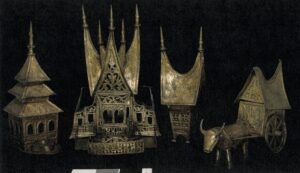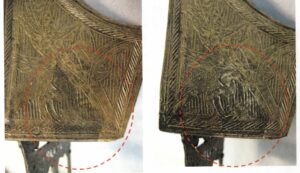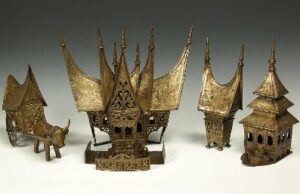April ’21
Minangkabau Homestead Model
The model depicts a style of architecture that is distinctive of the Minangkabau, an indigenous people of the island of Sumatra.

Minangkabau is a portmanteau of the words menang, meaning victorious, and kabau, meaning buffalo. The group takes their name from a local legend involving a territorial dispute between themselves and a neighbouring power. In order to settle the dispute peacefully, a fight between two water buffalo was held with each group entering an animal. Despite having less power in the region and entering a weaker animal, the Minangkabau were the winners. The buffalo is a unifying symbol in the Minangkabau culture, representing strength and courage, as well as being a measure of wealth and power.

The buffalo as a symbol of Minangkabau identity features prominently throughout their culture. The traditional architecture of the society is recognisable due to the large upward curving spires which adorn the roofs. The spires are thought to be an imitation of the upward curving horns of the buffalo. The largest spires are found on the rumah gadang, or main house of the Minangkabau family.
The Minangkabau people are a matrilineal society, with women regarded as the head of the family, and land is passed down from mother to daughter. Men are traditionally responsible for religion and politics.
Condition
- Dust, dirt and some soot visible on the surface and interior.
- Yellowing lacquer visible on the surface.
- Patches of severe tarnish visible amongst the stable, yellow patina.
- Loose wheel on the cart.
- Incorrect assembly of the pieces.
Conservation

Initially the pieces of the object were cleaned using a soft bristle brush and a museum vac in order to remove the dust, dirt and soot from the surface. Following this, as the brass Minankabau homestead had patchy, yellowing lacquer on the surface, the decision was made to remove it. Solvent tests confirmed the lacquer was soluble in acetone. The pieces of the homestead were placed into a solvent rich atmosphere allowing the lacquer to soften enough that it could then be removed using cotton wool swabs with acetone. Each piece of the object was then examined under UV light to confirm whether the lacquer had been fully removed.

The brass Minangkabau homestead had developed a soft, yellow patina over the years and the desire by the Oriental Museum was to retain this patina. However, there were some areas, which appeared not to have developed this patina and were instead a lot darker in colour. Therefore, a treatment was required to make the surface of the metal uniform in appearance.
After numerous unsuccessful attempts to create an artificial yellow patina on a comparative object, the decision was made to treat the darkened areas with a mild abrasive in order to lighten them enough that they would blend with the yellow patinated areas. This would create a uniform surface and improve the aesthetics.
Finally a new coating of lacquer was applied to the object in order to help protect the surface from deterioration, and it also helped to ad a slight shine to the object, which highlighted the areas of decoration and detail.

As one of the cart wheels had been repaired using thin wire, and was therefore unstable, this old wire was removed and a thicker wire, similar to the original on the second wheel, was attached which allowed the cart and buffalo to be displayed with the rest of the Minangkabau Homestead.
Stay tuned for next month’s object!
